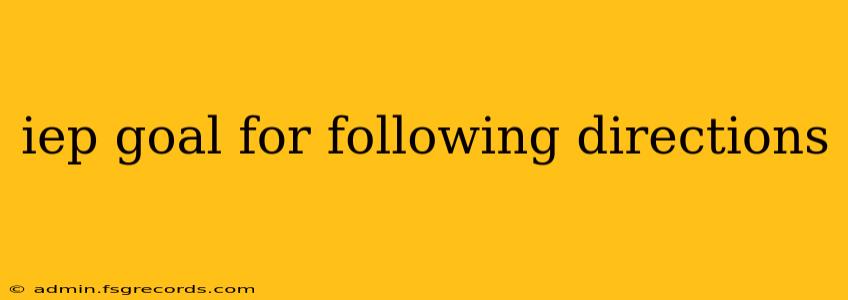Developing the ability to follow directions is crucial for a child's success in school and life. For students who struggle with this skill, an Individualized Education Program (IEP) goal specifically targeting this area is essential. This guide provides a framework for creating effective and measurable IEP goals for following directions, covering various aspects and complexities.
Understanding the Nuances of Following Directions
Before crafting an IEP goal, it's vital to understand the specific challenges the student faces. Does the student struggle with:
- Auditory Processing: Difficulty understanding verbal instructions.
- Working Memory: Trouble retaining multiple steps or instructions.
- Attention: Easily distracted and unable to focus on the task.
- Organizational Skills: Difficulty sequencing tasks or steps.
- Motor Planning: Problems executing the physical actions required by the directions.
- Reading Comprehension: Struggles to understand written instructions.
Identifying the root cause allows for a targeted and effective IEP goal. For instance, a student with auditory processing issues will require different support than a student with working memory difficulties.
Crafting Measurable IEP Goals: Examples and Templates
A well-written IEP goal uses the SMART framework: Specific, Measurable, Achievable, Relevant, and Time-bound. Here are examples showcasing different aspects of following directions:
Example 1: Focus on Auditory Processing
- Goal: Given oral, one-step directions in a quiet setting, [Student's Name] will accurately follow the directions 80% of the time across 5 consecutive observation periods by [Date].
Example 2: Addressing Working Memory Challenges
- Goal: Given oral, two-step directions in a quiet setting with a visual cue, [Student's Name] will accurately follow the directions 75% of the time across 5 consecutive observation periods by [Date].
Example 3: Targeting Attention and Organization
- Goal: Given a written, three-step task with a visual checklist, [Student's Name] will complete the task accurately, demonstrating appropriate sequencing of steps, 70% of the time across 5 consecutive observation periods by [Date].
Example 4: Multi-Sensory Approach (Visual and Auditory)
- Goal: Given a combination of oral and visual directions (pictures or diagrams) for a four-step task, [Student's Name] will complete the task accurately 65% of the time across 5 consecutive observation periods by [Date].
Template for IEP Goals:
- Given [Type of Direction: oral, written, visual, etc.], [Number of Steps] directions [Setting: quiet, noisy, etc.], [Student's Name] will accurately follow the directions [Percentage]% of the time across [Number] consecutive observation periods by [Date].
Remember to replace the bracketed information with details specific to the student's needs and abilities.
Beyond the Goal: Strategies and Interventions
The IEP goal is only one part of the equation. Effective interventions and strategies are crucial for success. These might include:
- Chunking Information: Breaking down complex directions into smaller, manageable steps.
- Visual Supports: Using pictures, diagrams, or checklists.
- Repetition and Modeling: Repeating directions and demonstrating the task.
- Positive Reinforcement: Providing praise and rewards for successful attempts.
- Assistive Technology: Exploring tools like voice-to-text or text-to-speech software.
- Sensory Regulation Strategies: Addressing underlying sensory sensitivities that might impact attention and focus.
Collaboration and Regular Monitoring
Regular monitoring of the student's progress is crucial. The IEP team (teachers, parents, therapists, etc.) should meet regularly to review the student's performance, adjust strategies if needed, and celebrate successes. Open communication and collaboration between all stakeholders are vital for the student's growth and development.
By employing this comprehensive approach, educators can create effective IEP goals for following directions, leading to significant improvements in a student's academic and overall success. Remember to tailor the goal and interventions to the student's specific needs and learning style for optimal results.

